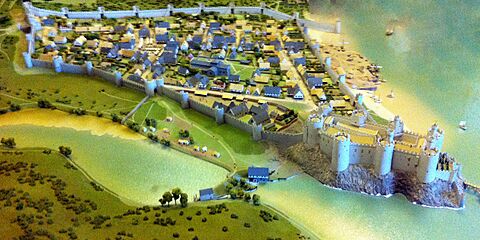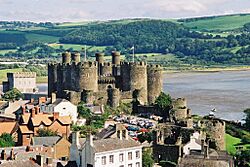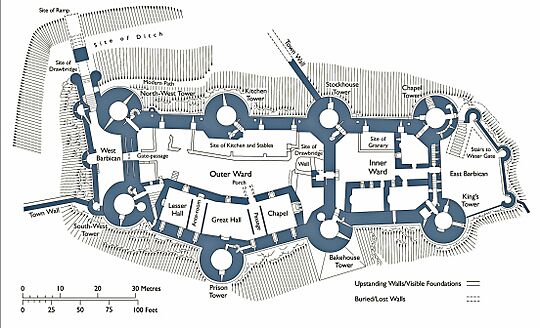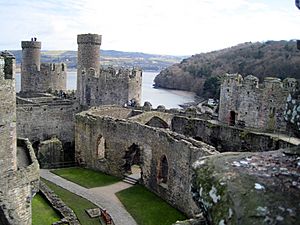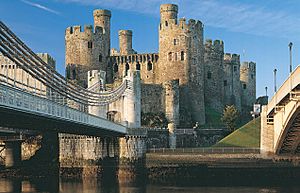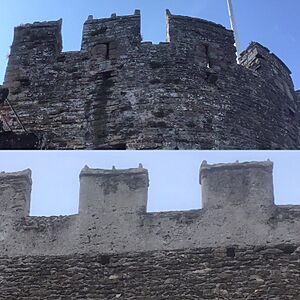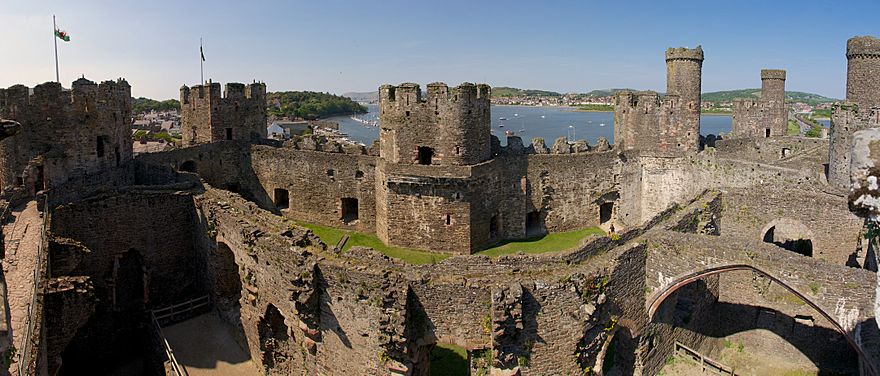Conwy Castle facts for kids
Quick facts for kids Conwy Castle |
|
|---|---|
| Castell Conwy | |
| Conwy, Wales | |
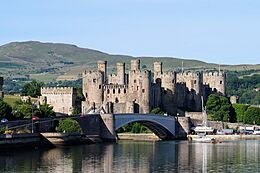
Conwy Castle from the river
|
|
| Coordinates | 53°16′48″N 3°49′32″W / 53.28°N 3.825556°W |
| Type | Rectangular enclosure castle |
| Site information | |
| Owner | Cadw |
| Condition | Ruined |
| Site history | |
| Built | 1283–89 |
| Built by | James of St. George |
| Materials | |
| Events |
|
| UNESCO World Heritage Site | |
| Part of | Castles and Town Walls of King Edward in Gwynedd |
| Criteria | Cultural: i, iii, iv |
| Inscription | 1986 (10th Session) |
|
Listed Building – Grade I
|
|
| Designated | 1950 |
Conwy Castle (in Welsh, Castell Conwy) is a huge old castle in Conwy, North Wales. It was built by King Edward I of England between 1283 and 1287. This was during his time of taking control of Wales. The castle was part of a bigger plan to build a walled town around Conwy. Building both the castle and the town walls cost a massive £15,000 back then!
Over hundreds of years, Conwy Castle was important in many wars. It survived a long attack by Madog ap Llywelyn in 1294–95. It also gave King Richard II a safe place to stay in 1399. Later, in 1401, forces loyal to Owain Glyndŵr held the castle for several months.
During the English Civil War (1642–1646), the castle was held by supporters of King Charles I. They finally gave up in 1646 to the Parliament's army. After this, parts of the castle were destroyed on purpose so it couldn't be used in future fights. By 1665, it was completely ruined when its metal parts were taken and sold.
In the late 1700s and early 1800s, Conwy Castle became a popular spot for artists. More and more visitors came, and work began to fix up the castle in the late 1800s. Today, the ruined castle is looked after by Cadw, a Welsh government group, and is a popular place for tourists to visit.
UNESCO thinks Conwy Castle is one of the "finest examples" of military buildings from the late 1200s and early 1300s in Europe. It is a World Heritage Site, which means it's a very important historical place.
The castle is shaped like a rectangle and is made from local stone. It sits on a ridge by the coast, looking over an important river crossing. It has an Inner Ward and an Outer Ward, which are like two main sections. Eight big towers and two barbicans (strong outer defenses) protect it. There's also a secret gate leading to the river, which allowed supplies to be brought in by boat. Conwy Castle has the oldest stone machicolations (holes for dropping things on attackers) in Britain. A historian named Jeremy Ashbee said it has the "best preserved" medieval royal rooms in England and Wales. The castle's design is similar to buildings in the Savoy region of Europe. This is probably because the main architect, James of Saint George, was from there.
Contents
History of Conwy Castle
Building the Castle (1200s)
Before the English built Conwy town, there was a Welsh monastery called Aberconwy Abbey on this spot. Welsh princes also had a palace (called a llys) here. Part of the town walls still includes a wall and tower from a palace belonging to Llywelyn the Great and his grandson Llywelyn ap Gruffudd. This old part is from the early 1200s and looks different from the rest of the walls.
The location was also key because it controlled a crossing point over the River Conwy. This river connected the coast to inland areas of North Wales. English kings and Welsh princes had fought over this area for a long time. In 1282, King Edward I decided to take control of North Wales.
Edward invaded with a huge army. He captured Aberconwy in March 1283. He decided to move the abbey and build a new English castle and walled town on the monastery's old site. This was a way to show English power.
Work on the castle started quickly. Sir John Bonvillars managed the project, and master builder James of St. George oversaw it. The first part of the work (1283-1284) focused on building the outer walls and towers. From 1284 to 1286, the inside buildings were put up, and work began on the town walls. By 1287, the castle was finished. Many workers from all over England helped build it. The total cost for the castle and town walls was about £15,000, which was a huge amount of money back then.
The castle's leader, called the constable, was also the mayor of the new town. The castle had a group of 30 soldiers, including 15 crossbowmen. There was also a carpenter, a chaplain, a blacksmith, an engineer, and a stonemason. In 1294, Madog ap Llywelyn led a Welsh rebellion. Edward I was trapped in Conwy Castle by the Welsh from December 1294 to January 1295. Supplies could only reach him by sea. His army finally arrived to help him in February. The future King Edward II also visited the castle in 1301.
Challenges and Changes (1300s–1500s)
Conwy Castle was not kept in good shape in the early 1300s. By 1321, a report said it had few supplies and leaky roofs. These problems continued until Edward, the Black Prince, took charge in 1343. His chamberlain, Sir John Weston, made repairs, adding new stone arches to the great hall. But after the Black Prince died, the castle was neglected again.
At the end of the 1300s, King Richard II used the castle as a safe place from his rival, Henry Bolingbroke. In August 1399, Richard met Henry's messenger at the castle. Richard later gave up at Flint Castle and died in prison.
In April 1401, during the rebellion led by Owain Glyndŵr, two of Owain's cousins, Rhys and Gwilym ap Tudur, attacked Conwy Castle by surprise. They pretended to be carpenters and got inside, killed the guards, and took over the fortress. Welsh rebels then captured the rest of the walled town. The brothers held the castle for about three months before agreeing to surrender. They were given a royal pardon.
During the War of the Roses (1455–1485), Conwy Castle was made stronger but didn't play a big part in the fighting. King Henry VIII had repair work done in the 1520s and 1530s. At this time, the castle was used as a prison and a storage place.
Decline and Revival (1600s–Today)
By the early 1600s, Conwy Castle was falling apart again. King Charles I sold it in 1627. When the English Civil War began in 1642, Archbishop John Williams took charge of the castle for the king. He paid for repairs and soldiers himself. In 1645, Sir John Owen became governor, causing a big argument between the two men. The Archbishop then joined Parliament's side. The town of Conwy fell in August 1646, and the castle was finally captured in November after a long attack.
After the siege, Colonel John Carter became governor, and more repairs were done. In 1655, Parliament ordered the castle to be "slighted," meaning it was made unusable for military purposes. The Bakehouse tower was probably partly pulled down then. When King Charles II returned to power in 1660, the castle was given back to its owner. But five years later, the owner decided to strip the remaining iron and lead from the castle and sell it. This work turned the castle into a complete ruin, even though the people of Conwy tried to stop it.
By the late 1700s, the ruins were seen as beautiful and dramatic, attracting visitors and artists. Many famous painters, like J. M. W. Turner, painted the castle. In the 1800s, several bridges were built across the River Conwy, making it easier to reach the castle. This brought even more tourists. In 1865, the town of Conwy took over the castle. Restoration work began, including rebuilding the damaged Bakehouse tower.
In 1953, the castle was leased to the Ministry of Works, and a lot of repair work and research was done. Another road bridge was built to the castle in 1958. Conwy Castle was already a protected historical site. In 1986, it became part of the "Castles and Town Walls of King Edward in Gwynedd" World Heritage Site.
Today, Cadw manages the castle as a tourist attraction. In 2010, over 186,000 tourists visited. A new visitor center opened in 2012. The castle needs ongoing care, with repairs costing around £30,000 in 2002–03. In December 2023, Condé Nast magazine named Conwy Castle the most stunning castle in Europe.
Castle Design and Features
The castle sits on a rocky ridge made of grey sandstone and limestone. Much of the stone used to build the castle came from this ridge itself. However, the local stone wasn't good enough for detailed carvings like windows. So, better sandstone was brought in from other areas like the Creuddyn peninsula and Chester. This imported stone was more colorful and was probably chosen to make the castle look better.
The castle has a rectangular shape and is divided into two main parts: an Inner Ward and an Outer Ward. A wall separates these two sections. Each side of the castle has four tall towers, about 70 feet high. Originally, the castle would have been painted white. You can still see holes on the outside of the towers where wooden supports were placed during construction. The top parts of the walls, called battlements, used to have fancy triple designs.
The main way into the castle is through the western barbican. This is an outer defense in front of the main gate. When it was first built, you reached the barbican by crossing a drawbridge and a steep stone ramp. The barbican has the oldest stone machicolations in Britain. The gate would also have had a portcullis, a heavy metal gate that could be lowered.
The gate leads into the Outer Ward. This area originally had many buildings for administration and services. One tower held storage and some living spaces. Another tower might have been used by the castle's constable or soldiers, and it also had a bakehouse. On the south side of the Outer Ward, there was a great hall and a chapel, built over cellars. Behind the great hall was a tower used for holding prisoners, including a special "debtors' chamber" and an underground dungeon. On the north side, there were service buildings like a kitchen, brewery, and another bakehouse.
The Inner Ward was separated from the Outer Ward by an inner wall, a drawbridge, and a gate. A ditch cut into the rock also protected it. This ditch was filled in later, and the drawbridge was removed. A well, fed by a spring, is still there and is 91 feet deep. The Inner Ward held the rooms for the royal family and their staff. A historian believes these are the "best-preserved" medieval royal rooms in England and Wales. They were designed like a small royal palace. If needed, this area could be sealed off from the rest of the castle and supplied by sea through the eastern gate.
The royal rooms were on the first floor, facing a courtyard. The four towers protecting the Inner Ward had service areas. The Chapel Tower held the private royal chapel. Each tower also had a small watchtower turret, probably for security and to display the royal flag. The design was similar to a 13th-century royal area at Corfe Castle. It gave the king privacy and good security. Later, the two sets of royal rooms were combined into one larger set.
On the east side of the Inner Ward is another barbican, which enclosed the castle garden. This garden changed over the years, from a lawn to a vineyard, then to apple trees and formal flowers. A secret gate once led down to the river, where a small dock allowed important visitors to enter privately and for supplies to be brought in by boat. This gate is now hidden by the bridges built later.
The design of Conwy Castle is very similar to buildings found in the County of Savoy during the same time. This includes window styles, the type of battlements on the towers, and the placement of holes for scaffolding. This is usually thought to be because the main architect, Master James, was from Savoy. For example, the three-pointed battlements are seen at Castello San Giorio di Susa in Savoy, which Edward I visited in 1273.
Constable of the Castle
The Constable of Conwy Castle had several important jobs:
- Being the Governor of the castle.
- Being the Governor of the fortified town.
- Being the keeper of the castle's prison (called a gaol).
- Being the Mayor of the town.
In 1283, the castle had a group of people living and working there:
- 30 men (soldiers)
- 15 crossbowmen
- 1 person in charge of weapons
- 1 chaplain (a religious leader)
- 1 stonemason (a builder who works with stone)
- 1 carpenter (a builder who works with wood)
- 1 artisan (a skilled worker)
- And 10 other people.
The first constable of the castle was William De Sikun.
Images for kids
See also
 In Spanish: Castillo de Conwy para niños
In Spanish: Castillo de Conwy para niños
- Castles in Great Britain and Ireland
- List of castles in Wales
- List of Scheduled Monuments in Conwy



